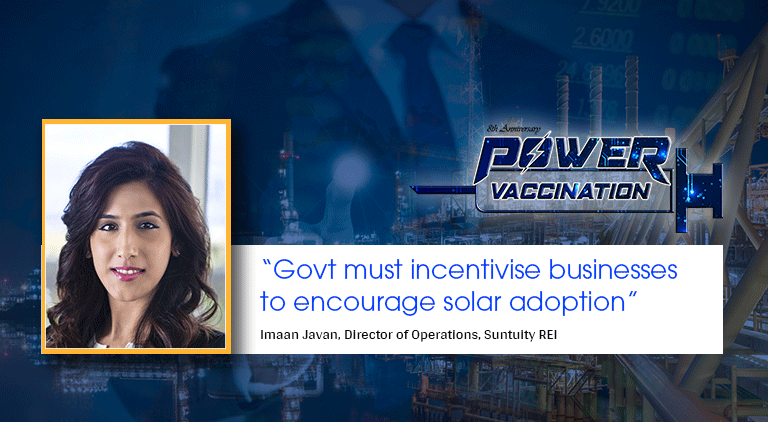Govt must incentivise businesses to encourage solar adoption
By EPR Magazine Editorial October 30, 2020 8:01 pm IST
By EPR Magazine Editorial October 30, 2020 8:01 pm IST

Suntuity REI, part of a US based Suntuity Group, is one of the leading solar power solutions and solar panel installation companies in India. Commenting on how the solar sector is turning the tide in its favour despite challenges, the company’s Director of Operations Imaan Javan said, “Despite the challenges, the Indian solar sector has left no stone unturned in ensuring smooth delivery and expedited completion of projects with every phase on unlock.”
What’s your take on the recent performance of solar power sector in India?
Though the Indian solar power sector has grown exponentially in the last few years, there is still scope for more. India is still heavily dependent on foreign import of modules due to their quality, affordability and ease of viability. However, in the recent past, the government has implemented quite a few policies to boost the growth of the domestic manufacturing sector such as the Safeguard Duty, Anti-Dumping Duty.
Although India installed 7.9 GW in 2019 thus securing its spot as the third largest solar market in the world along with a cumulative installation of 35.7 GW by December, the pandemic has had a hard hitting effect on the industry. Rooftop solar installations were at a four year low between January and June 2020 due to the pandemic coupled with financing costs and policy changes. As per a Bridge to India report, a meagre 437 MW was installed in the first half of the year as compared to 1,534 MW the same time last year, as consumers from the residential and industrial segments backed out. In addition to that, solar power developers have had to face heavy penalties for delayed project completions due to the lockdown. A month’s delay in completing a 100 MW project can cost a developer a whooping Rs 1.28 million ($17,413) in penalties.
As of June 2020, India installed 5,935 MW of rooftop solar of which C&I (commercial and industrial) segment accounted for 73 percent while residential was 804 MW. This pinpoints the fact that India is still way behind in achieving the ambitious target of 175 GW by 2022.
What is the future of Indian solar power sector in 2021?
The solar sector in India holds immense potential to be at par with the global counterparts. With tensions around China and our Prime Minister announcing ‘Atmanirbhar Bharat’ and ‘Vocal for Local’, the domestic sector now has the scope to resort to the locally produced modules or equipment whose quality and pricing are equivalent to the foreign products thus contributing to the country’s GDP and also encouraging the manufacturers to penetrate into the international markets to showcase their offerings.
While we appreciate the government’s efforts to allocate land near ports to set up solar manufacturing hubs to attain dominance over China and resort to self-reliance, they should relook at introducing and implementing favourable measures to support the installers for smoother and faster project completions. Also, we are hopeful that the Prime Minister’s ambitious vision of ‘One Sun One World One Grid’ which will connect 140 nations together will open up more opportunities for the Indian developers.
What will drive the growth of solar power business beyond 2020?And although the government is introducing measures to boost the sector, the sector is still facing shortage of raw materials and labour. Policies for hassle-free and seamless installations are still one of the most important requirements for the installers as well as the customers, for the sector to reach its optimum potential. Also, to aid the industry in its growth, the government must incentivise businesses to encourage adoption of solar energy.
Despite challenges, how is the industry turning the tide in its favour?
The recent pandemic has enormously affected businesses across the world. The solar industry was no exception and the impact was grave as projects were stalled, units were shut or asked to operate at minimal strength resulting in delayed production and installations. This only expanded the demand supply gap further.
The hike in Chinese module prices along with a delay in BIS certification of existing and new models has solar developers in the country facing challenges in installations of rooftop projects. Almost 200 MW of capacity addition of EPC has been stalled and unless any substantial measures are being taken by the government, this can shoot up to 500 MW along with EPC players being insisted by suppliers to renegotiate the already signed contracts.
However, despite the challenges, the Indian solar sector has left no stone unturned in ensuring smooth delivery and expedited completion of projects with every phase on unlock. Also, they’ve taken this time out to educate companies about the cost effectiveness of solar thus driving in more investments from their end.
With appropriate government policies in place and educating the citizens of India on the lucrative benefits of solar adoption, we will only be able to maximise the demand in the sector while resulting in catapulted growth.
Imaan Javan, Director of Operations, Suntuity REI
We use cookies to personalize your experience. By continuing to visit this website you agree to our Terms & Conditions, Privacy Policy and Cookie Policy.